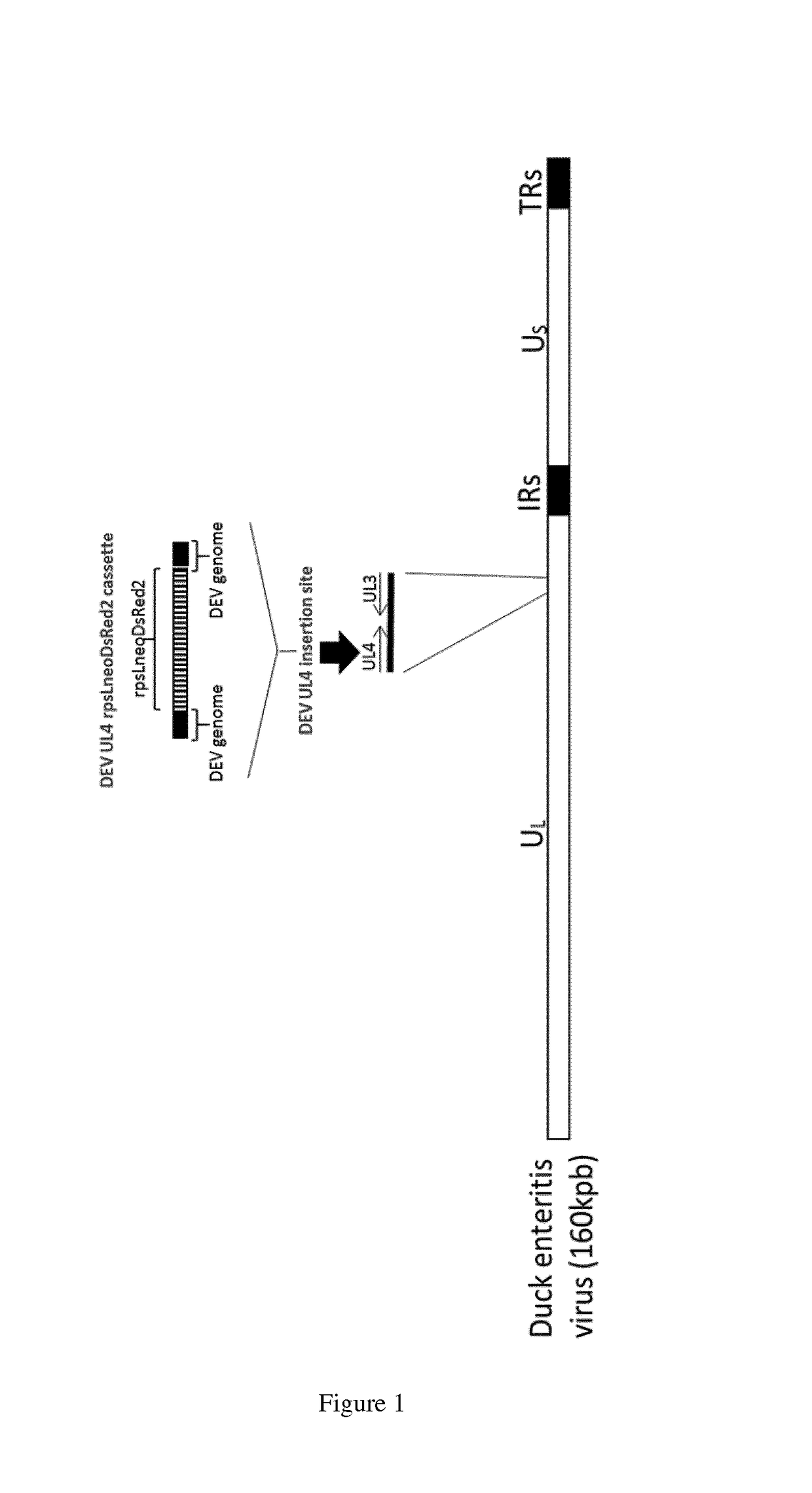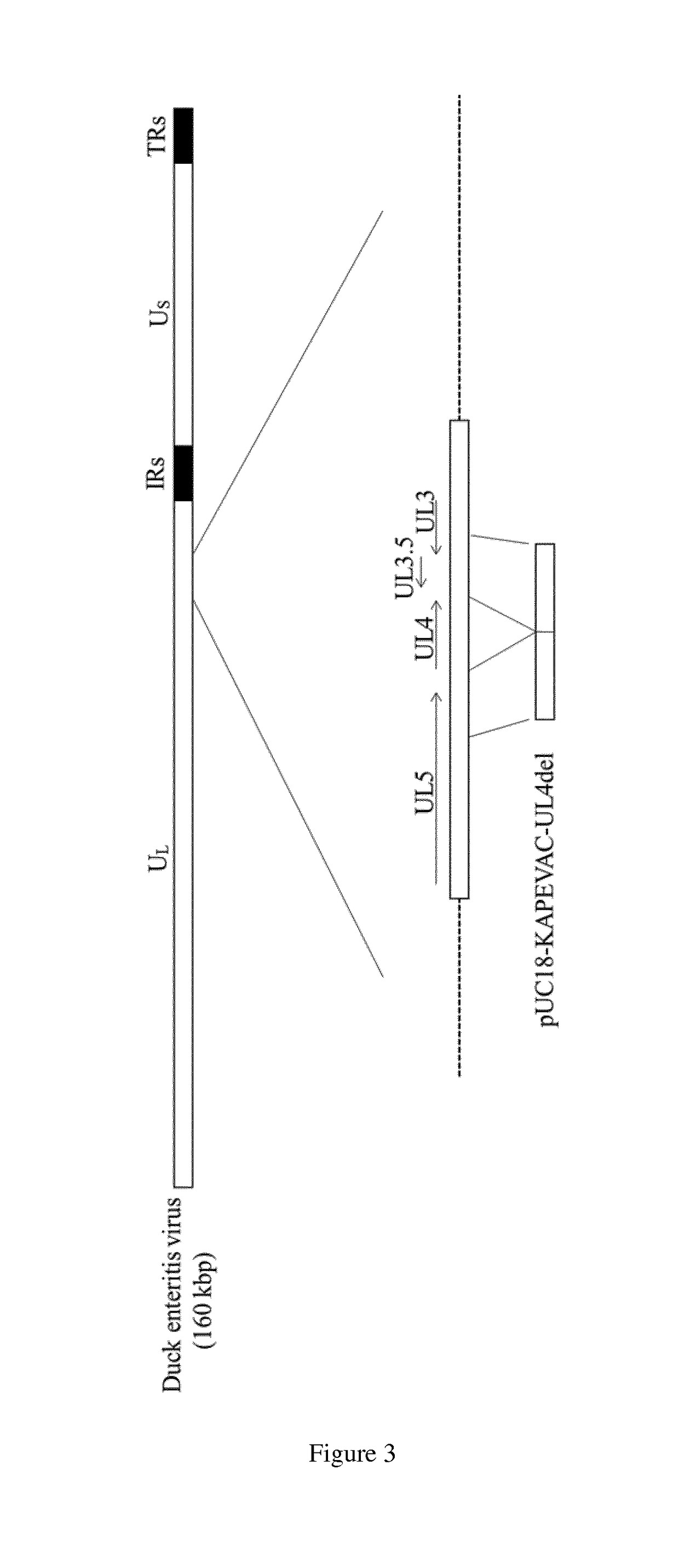Duck enteritis virus and the uses thereof
a technology constructs, which is applied in the field of duck enteritis virus constructs, can solve the problems of lethal virus and mass death of animals, and achieve the effects of no risk of dissemination or contamination, no risk of infection, and early onset of immunity
- Summary
- Abstract
- Description
- Claims
- Application Information
AI Technical Summary
Benefits of technology
Problems solved by technology
Method used
Image
Examples
example 1
of Wild-Type DEV in Eggs or Young Poultry
[0131]A clinical study was performed to investigate the pathogenicity or virulence of DEV at in chicken upon injection at different time schedule. More particularly, injection was performed in ovo (Day 3 before hatch), at Day 1 post-hatch, or at Day 4 post-hatch. DEV used was a wild-type DEV Jansen strain. The administered dose was either 100 or 1000 pfu / dose. As a control a PBS solution was administered in Group 1. Pathogenicity was assessed by measuring mortality each day after hatch.
[0132]The results are presented in the following table.
[0133]
DoseNumber of birds to death in each day of ageGroupVaccinepfuRouteDay1nD0D1D2D3D4D5D6D7D8>D92% Mortality1PBS—in ovo−3170000000002122DEV100in ovo−31632911—————1003DEV1000in ovo−3175291——————1004DEV1000sc1170000064211825DEV1000sc417000000000001Day of age at inoculation2Number of birds died between 9-day to 19-days of age
[0134]The above results show that injection of wtDEV at Day 4 post-hatch is safe wi...
example 2
ion of DEV Comprising an Inactive UL4 Gene
[0135]2.1 Construction of rpsLneo-DsRed2 Cassette
[0136]A 2.8-kb DNA fragment of rpsLneo-DsRed2 cassette was constructed by PCR reactions. Briefly, three PCR reactions were conducted. First PCR reaction was conducted using primer pair of SEQ ID NO: 1 (5′-GGCCTGGTGATGATGGCGGGATCGTTGTAT-3′) and SEQ ID NO: 2 (5′-CCATGGTGCTGCGCTCAGAAGAACTCGTCA-3′) with the template of synthesized fragment of rpsLneo (SEQ ID NO: 3). Second PCR reaction was conducted using primer pair of SEQ ID NO: 4 (5′-ACGAGTTCTTCTGAGCGCAGCACCATGGCC-3′) and SEQ ID NO: 5 (5′-TCGGAGGAGGCCATCCTTAAGAGCTGTAAT-3′) with the template plasmid of pSI Mammalian Expression Vectors (Promega, Cat# E1721). Third PCR reaction was conducted using primer pair of SEQ ID NO: 6 (5′-TACAGCTCTTAAGGATGGCCTCCTCCGAGA-3′) and SEQ ID NO: 7 (5′-GCAGTGAAAAAAATGCTTTATTTGTGAAAT-3′) with the template plasmid of pIRES2-DsRed2 (Clontech, Cat#632420). Another PCR reaction was conducted using a mixture of PCR produc...
example 3
n of Foreign Gene by Recombinant DEV Having Inactive UL4 Gene
[0143]Expression of the DsRed2 protein by the recombinant DEV / UL4 / rpsLneo-DsRed2 was confirmed by excitation for DsRed2. Excitation for DsRed2 was conducted using CEF cells infected with the recombinant DEV / UL4 / rpsLneo-DsRed2. Briefly, CEF cells in 6-well plate were infected with the rDEV / UL4 / rpsLneo-DsRed2 or the parent DEV strain at a multiplicity of infection of approximately 0.01. Three days post inoculation, cells were excited at 563 nm. Red fluorescence was only observed in the plaques of recombinant DEV / UL4 / rpsLneo-DsRed2.
PUM
| Property | Measurement | Unit |
|---|---|---|
| nucleic acid | aaaaa | aaaaa |
| genome structure | aaaaa | aaaaa |
| resistance | aaaaa | aaaaa |
Abstract
Description
Claims
Application Information
 Login to View More
Login to View More - R&D
- Intellectual Property
- Life Sciences
- Materials
- Tech Scout
- Unparalleled Data Quality
- Higher Quality Content
- 60% Fewer Hallucinations
Browse by: Latest US Patents, China's latest patents, Technical Efficacy Thesaurus, Application Domain, Technology Topic, Popular Technical Reports.
© 2025 PatSnap. All rights reserved.Legal|Privacy policy|Modern Slavery Act Transparency Statement|Sitemap|About US| Contact US: help@patsnap.com



